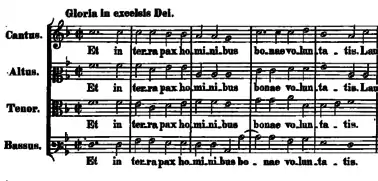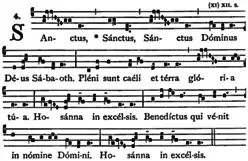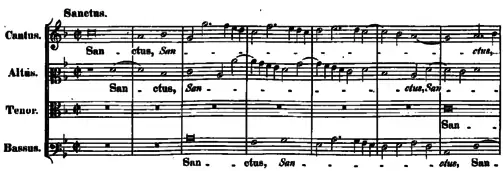Missa Brevis (Palestrina)
Missa Brevis is a mass written by Giovanni Pierluigi da Palestrina first published in 1570 in Palestrina's Third Book of Masses and has been Reprinted several times since.[1] The Title can be misleading as Missa Brevis is commonly a short mass. Palestrina likely chose the word Brevis as this was the most adequate word to portray the piece. Missa Brevis is considered to be one of the most performed of Palestrina's repertoire of polyphony.
Style
Missa Brevis is written for four voices, soprano, alto, tenor, and bass. The Benedictus, however, is for three voices, while the second Agnus Dei is for five.
Missa Brevis is written in F mode with B flat
Movements:
- Kyrie
- Gloria
- Credo
- Sanctus
- Benedictus
- Agnus Dei 1 & 2
An important characteristic of Palestrina expressed clearly in this work is the use of frequent tempo changes, which are governed entirely by the changing meaning and significance of the text. Hence there is a far greater feeling of phrase than of beat and rhythm. The unity of form which overwhelms the listener reflects very clearly the peace and serenity that Palestrina himself possessed in his faith. It is not known why the mass came to be called Missa Brevis, for it is not any shorter than the usual four part Palestrina mass.
Kyrie
4 voices

The Kyrie begins with a sevenfold opening imitation, contrasts a new melody for the Christe, and then closes with a motive similar to the first; the bassus voice caps the movement with an extended, downward melodic sequence. The opening motive starts in the alto and is gradually repeated throughout the other voices.
Gloria
4 voices

In the Gloria movement, Palestrina introduces textural contrasts, carefully balancing chordal and imitative textures. The opening motive is sung simultaneously through all four voices and is 3 bars long. The lengthy text passes quickly with syllabic writing and "telescoping"; the only repetition comes at the end, once again with a bass sequence.
Credo
4 voices

The Credo features balanced alternations between duo, trio, and full four-voiced textures, with a striking chordal homophony at the heart: Et incarnatus est. Yet again a bass sequence marks the end. The opening motive is sung as a duet between alto and soprano voices before the tenor and alto sing a variation of the original motive.
Sanctus
4 voices

It is in the Sanctus that Palestrina quotes the same chant melody (from the Gregorian Mass XV) as in the Missa Papae Marcelli; the movement's opening also resembles the melismatic Sanctus of that mass. To the right is a comparison of the two melodies, the first, from Sanctus in Missa Brevis and the second from Gregorian Chant XV.

Text:
Benedictus

3 Voices
Benedictus is written for only three voices, the soprano (cantus), the alto (altus), and the tenor. The opening motive is only three bars long before a variation on the melody is sung. Variations on this main melody are repeated throughout the piece.
Agnus Dei 1 & 2
1 - 4 voices
2 - 5 voices
Palestrina rounds out the mass cycle with two Agnus Dei settings; the second canonically expands the vocal texture by adding a second superius voice. To finish on an aspirant note, the very last concluding sequence arrives in this canonic upper pair.
Melody & Repetition
The melodic pattern of the Missa Brevis contains much that runs adjacent to what many consider aesthetically pleasing. The Harmonic quality of the balance between the voices is noticeably clear. The work lacks recurrent reference to the musical mode but is filled with repeating melodic features - noticeably a descending minor third followed by a brief scalic ascent (Noticeably prominent in the opening of the Kyrie)
The Missa Brevis is the epitome of Palestrina's style as the work balances the old and new modal usage of dissonances and accentuation as well as balancing imitative and homophonic textures. This is most prominently displayed in Palestrina's usage of many cantus firmi at the conception of each movement. This was revolutionary as it did not use partake of the principal of having a traditional unified Cantus firmus but instead favoured the parody technique (emphasising the use of the imitation technique or homophonic texture or using both) to create a free written mass.[2]
Interpretation of "Brevis"
Haberl Suggested the Brevis was chosen upon the display of each movement opening on a breve. However this was common practice at the time and is hardly worth any real acknowledgement.[3]
History
While Encyclopædia Britannica claims that the Missa Brevis was a part of Palestrina's era of 'conceptual' and entirely original works[4] In all probability Missa Brevis was written about the year 1558. There are indications that it could be based on a theme from Audi Filia, a mass by Claude Joudimel. There are other indications that it could come from the first notes of the Plainsong Credo I, while many parts of the mass are reminiscent of the plainsong mass Cum Jubilo, especially the Sanctus. It is written for four voices, soprano, alto, tenor, and bass. The Benedictus, however, is for three voices, while the second Agnus Dei is for five.
An important characteristic of Palestrina expressed clearly in this work is the use of frequent tempo changes, which are governed entirely by the changing meaning and significance of the text. Hence there is a far greater feeling of phrase than of beat and rhythm. The unity of form which overwhelms the listener reflects very clearly the peace and serenity that Palestrina himself possessed in his faith. It is not known why the mass came to be called Brevis (link to Missa Brevis article), for it is not any shorter than the usual four part Palestrina mass.
References
- "Palestrina: Missa Papae Marcelli & Missa brevis". Hyperion Records. Retrieved 2016-04-29.
- Alves, Chester (Aug 1994). "Palestrina's Style: The art of Balance". The Choral Journal V35.1.
- "Palestrina: Missa Papae Marcelli & Missa brevis". Hyperion Records. Retrieved 2016-04-29.
- "Missa brevis | work by Palestrina". Encyclopædia Britannica. Retrieved 2016-04-29.